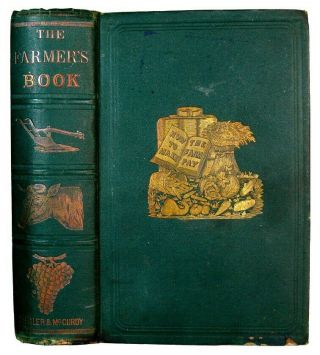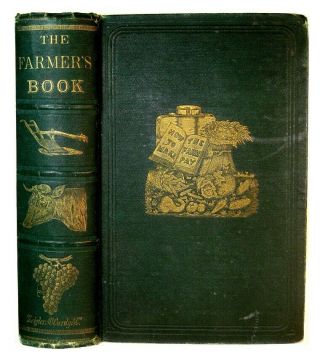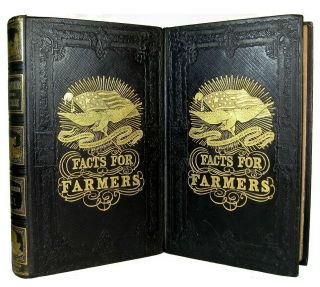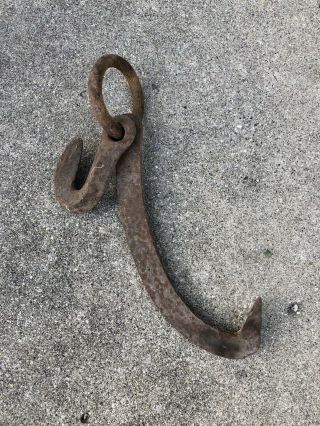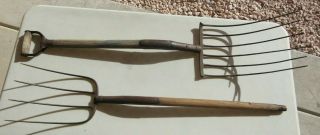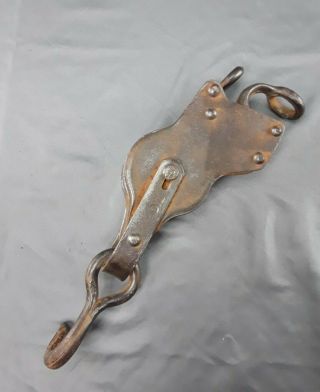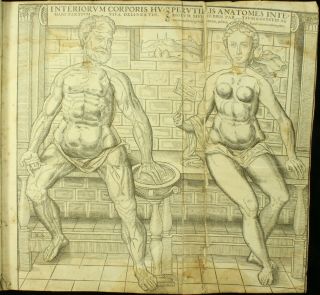Original Description:
Note: Many of my clients are farmers, artisans, inventors, fabricators, housekeepers, etc. who are seeking specific information related to their fields of interest. For their convenience I include the following details directly from this book: Subjects, Recipes/Receipts, Etc. Discussed or Illustrated in this Book (General Only, See Full Contents Below): Farm Farmer Farming Home Household Farmhouse Guide Manual Illustrated Antique Instruction Reference How-To Planting Wintering Pl...owing Fertilizing Crops Vegetables Potato Corn Dairy Fruit Trees Horse Care Farrier Equestrian Veterinarian Horse Training Taming Cattle Cow Milking Poultry Chicken Turkey Eggs Drainage Soils Manure Fertilizer Plowing Plow Farm Implements Tools Carey Plow Tree Sawing Machines Stump Pullers Stone Lifters Draught Doe Plow Deep Tiller Plows Telegraph Plow Cylinder Plow Conical Plow Steel Plows Skinner's Gang Plow Steam Plow Comstock's Spader Harrows Rollers Wheat Harvesting Harvest Barley Buckwheat Oats Indian Corn Planters Grasses Clover Hay Root Crops Potato Turnip Carrots Crop Rotation Sugar Stock Raising Horse Mule Stable Cow Cattle Dairy Devon Hereford Ayrshire Holsteins Sheep Swine Husbandry Piggery Farm Dogs Shepherd Dog Poultry Chicken Geese Turkey Rooster Hen Bee Keeping Bees Apiary Swarms Fruit Culture Orchard Nursery Pruning Grafting Apple Pear Quince Peach Plum Cherries Neetmok Insect Pests Grape Culture Wine Making Vintner Vineyard Management Small Fruit Culture Currant Gooseberry Rural Architecture House Home Dwelling Farmhouse Landscaping Gardens Laborer Cottage Ice House Farm Buildings Trees Farmer’s Garden Farmer’s Market Cultivation Fences Butter Making Domestic Economy Family Recipes Cookery Cookbook Bread Meat Pastry Dessert Cake Pies Biscuits Oatmeal Hominy First Aid Medicine Family Physician Cures Home Remedies HOW TO MAKE THE FARM PAY; OR, THE FARMER’S BOOK OF PRACTICAL INFORMATION On Agriculture, Stock Raising, Fruit Culture, Special Crops, Domestic Economy & Family Medicine. By Charles W. Dickerman. Assisted by Hon. Charles L. Flint. Published in 1880 by P.W. Zeigler & Co., Philadelphia. 9” x 6” cloth hardcover. Illustrated. 774 pages, with a 40-page appendix entitled "Australian Farmers' Journal." Condition: VERY GOOD ANTIQUE CONDITION. Exterior as shown in photo, with light wear. Inner hinges are strong, binding is firm. Text is clean and complete. Minor foxing and toning, No torn, loose or missing pages. Great example of this rare 19th-century farming guide. Description: This is HOW TO MAKE THE FARM PAY; OR, THE FARMER’S BOOK OF PRACTICAL INFORMATION. 770 pages long and wonderfully illustrated, it was written for the benefit of farmers both prospective and established. The book is divided into four parts, covering general agriculture (soil, drainage, fertilizer, which crops are best to grow, crop rotation, ensilage, etc) and farm implements; stock raising (horses, mules, cattle, sheep, swine, goats, poultry and bees); fruit culture and wine-making; and rural architecture, gardening, cookery recipes and family health and first aid. The Preface proclaims: No one at this day doubts the importance of agricultural information. Knowledge in this department is not only power, but it is wealth, individual and national. To make the present volume wholly reliable, it has been aimed to record nothing but what has been proved in practice, beyond a doubt.To give you a clearer and stronger idea of what you’ll find in HOW TO MAKE THE FARM PAY; OR, THE FARMER’S BOOK OF PRACTICAL INFORMATION, THE AMERICAN FARMER Volume I, I have furnished some helpful details below, including a detailed summary of the book’s contents and some examples of the book’s handsome illustrations. I hope you’ll take a few moments to have a look. CONTENTS ARE: PART FIRST – GENERAL AGRICULTURE AND FARM IMPLEMENTS: CHAPTER ONE ~ DRAINAGE: What Soils need Drainage * Signs * Effects of Stagnant Water upon various Crops * Shortens the Working Season * Shortens the Ripening Season * Effects of Drainage * Removes Stagnant Water from the Surface * Removes Surplus Water from under the Surface * Lengthens the Working Season * Deepens the Soil * Warms the Under Soil * Equalizes the Temperature * Prevents Injuries by Frost * Prevents Injury from Drought * Increases the Effect of Manures * Prevents Rust in Wheat and Rot in Potatoes * Other advantages * Material for Drains * Open Drains * Brush * Stoue Drains * Tile * Why the best * Depth of Drains * Draining Tools * Time to make Drains * Laying out * Digging * Mains * Minors * Joints * Heads * Outlets * Obstructions * How discovered * How remedied * Ditching Machines * Mole Drains, etc , etc. * Draining Prairie Land CHAPTER TWO ~ PLOWING: Objects * Pulverization * Wet Soils * Deep Plowing * Shallow Plowing * Increase your Acre * Lapped Furrow Slices * Double Furrow Slices * Flat Furrow Slices * Trench Plowing * Benefits of Trench Plowing * Subsoil Plowing * Benefit * When not applicable * Fall Plowing * Winter Plowing * Spring Plowing * Which the best * Why * Stubble Plowing * Plowing Clay Soils * How to Plow * Heavy and Light Plows * Breaking Prairie * Harrowing * Rolling * Clod Crushing CHAPTER THREE ~ MANURES: Waste of Manures * One Thousand Dollars a Year to waste * Liquid Manure * Human Excrement * How to save it * Its value * The Barnyard * More waste * Urine * Manure Wells * Soiling * Horse Manure * Liability to " fire fang" * Loss of Ammonia * Its value * How to prevent it * The Piggery * Hen Dung * Liquid Manure alone valuable * Application to the Soil * Surface Manuring * Fall Manuring * Spring Manuring * Protected and unprotected Manures * Peat * Muck * Straw * Leaves * Bones, and how to Dissolve them * Dead Horses, etc. * Ashes * Sawdust * Soot * Soap * The Sink Spout and Privy * Red Clover as a Manure * Other Green Manures * Their value * Plowing them under * Make the most of your Manure * When to use Fertilizers * Guano, the same thing as Hen Dung * Lime * A necessity * Its application * Gypsum * Plaster of Paris * Do Fertilizers exhaust the Soil * Composts * Drainage necessary to give effect to manures * Last words CHAPTER FOUR ~ FARM IMPLEMENTS: Amount of Capital invested in them * Improvements * One Plow to a town * The Carey Plow * Shovel Plow * Implements for preparing the Land * Tree Sawing Machines * Stump Pullers and Stone Lifters * Drainage and Draining Implements * Plows and Plowing * Draught * The Doe Plow * Its general application * Deep Tiller Plows * Telegraph Plow * Cylinder Plow * Mead's Conical Plow * Sod, Stubble, and Side Hill Plows * Steel Plows * Their advantages * Collins Plow * The Subsoil Plow * Its great usefulness * Other Plows * Dr. Grant's New Trenching Plows * Plows for the Prairie Farmer * Skinner's Gang Plow * Steam Plow * Comstock's Spader * Harrows * Geddes' Harrow * The Hinge Harrow * Share's Harrow * Horse Hoes-Cultivators * Sulky Cultivator * Clod Crusher * Rollers * Cooper's Lime Spreader * Drills * The advantages of Drilling in most Crops * The Star Drill * Seed Sowers * Weeding Hoes * Allen's "Weed Killer" * Implements for Harvesting * The rapid march of improvements * Number of Mowing Machines manufactured * Their progress towards perfection * The Buckeye * Woods * Other Mowers * The Hay Tedder * Its remarkable success * Horse Rakes * Forks * Horse Forks * Reaper Trials * Self Rake Reapers * Automatic Binders * Combined Mowers and Reapers * Preservation and care of Implements * Valuable directions * Threshing Machines * Corn Shellers * Hay Fodder and Root Cutters * Cider and Grape Mills CHAPTER FIVE ~ GRAINS: Wheat Culture * Its importance * The corner stone of Wheat Culture * Drainage * Soils * Clay * Limestone * Sandy Soils * Mistake in Prairie Farming * Manures required * Clover Fallows * Cost of Manuring with Clover * Its value * Lime, Ashes, Salt, etc. * Relative value of each to the Wheat Crop * Fattening the Soil * Thorough Pulverization * Sheep vs. Cattle * Preparing the Soil for Wheat * Deep Cultivation * Mellowing the Soil * Sowing * Early and Late Sowing * The Depth * Amount of Seed to the acre * Drilling in the Seed * Can be done earlier * Less Seed required * Uniformity secured * Other advantages * Harrowing Wheat in the Spring * Chess, Grass, and Weeds * Time to Harvest Wheat * Signs of Ripening * Reaping * Cradling * Raking * Binding * Stacking * Grain Caps * Spring Wheat * Special directions * Selection of Seed Wheat * Carelessness in selecting Seed the great bane of Agriculture * Qualities of Good Wheat * Varieties of Wheat * Their Qualities described * If not properly selected and carefully cultivated the best Wheat will degenerate * Smut * Rust * Mildew * Ergot * Insects.* Soils * Preparation * Manures * Sowing * Harvesting * Selection of Seed * Barley, Buckwheat, Oats * Varieties * Soils best adapted to their Culture * Their place in the rotation of Crops * Manures to be applied * Preparation of the Soil * Harvesting, etc., etc. * Indian Corn * The Staple Crop * Cotton no longer King * Soil * Autumn Plowing * Manures * Lime * Salt * Guano * Ashes * Bones, etc. * Preparing the Seed * Time to Plant * Corn Planters or Drills * Cultivation * Southern and Western Methods * How can they be improved * Corn for Fodder * Topping condemned * Harvesting * Huskings * Raising, selecting and preserving Seed Corn * Varieties * Broom Corn * Legal Weights of Grains, Roots and Seeds in different States * Number of Seeds to the pound of different Grains and Grasses CHAPTER SIX ~ GRASSES: Purposes for which Grass is cultivated * Hay * Pasture * Thirty Species of Agricultural value * Varieties of Grass described * Their relative value * Red Clover * Time for Seeding Clover * Quantity of Seed per acre * Cutting and Curing * Early vs. Late Cutting * Curing in one day * Cutting for Seed * Hay Caps * Clover as a Manure * Time to Sow Grass Seed * Early Spring vs. Fall Sowing * Quantity of Seed per acre * Too small a variety of Seed usually sown * Twenty varieties in natural sod * Mixtures recommended * Tables * Top dressing Grass Lands * Seeding wet Prairie * Red Top vs. Slough Grass * Improvement of Pastures * Selection of Grass Seed * Raise your own Seed CHAPTER SEVEN ~ ROOT CROPS: The best Farming implies a Culture of "Roots" * Roots for Stock in Winter * Relative value of Roots and Corn * Where Roots can be raised to advantage * Soil * Preparation * Manures * Turnips * Ruta Bagas * Mangolds * Carrots * General Cultivation * Harvesting * Storing * Feeding * Careful seleptiou and preparation of Seed * Drilling vs. Sowing * Profits. Potatoes. General use * Preparation of the Soil * Manures and their application * Planting whole or cut, large or small, in Hills or Row.s * Cultivation * Harvesting * Storing * Varieties * Characteristics of a good Potato * Description of thirteen good varieties * Sweet Potatoes CHAPTER EIGHT ~ SPECIAL CROPS AND ROTATION OF CROPS: Cotton: Its great importance * Cheap Cotton means Cheap Clothing * Three classes of soils * Cotton States * Division of a Cotton Plantation * Plowing * Planting * The Seed * Circle Plowing * Marking off * A cheap Marker * Distance to Plant * Drilling in * Dropping by hand * Rules of Dr. Cloud * Fertilizers * The best and their application * Cultivation * First Plowing * Bringing to a stand * Keeping out the Weeds * Care for the Laborers and Stock * Picking * When to commence * Directions of J. B. Lyman * Ginning, Baling, and Marketing * Suggestions * A common Gin House * Home Manufacture * Diseases * Insects * Certain methods of preventing their ravages * Cotton Seed * Oil Cake * Rice Culture. Tobacco:. Does it exhaust the Soil * Faulty methods of Culture * Soil * Preparation * Sub-soiling * Manures the life of the Crop * What Manures * The Seed Bed * How much Seed * Transplanting * Cultivation * Enemies * Suckers * Worms * Topping * Indications of Ripening * Harvesting * Frost * Curing * Artificial Curing * Bibb & Co.'s Apparatus * Sweating. Hops. Soil * Underdraining * Position * Preparation of the Soil * Fertilizers * Runners * Transplanting * Planting out * Sets * Distance * New and improved method of Training * The Hop Lou.se * Prevention * Gathering * Drying * Storing. * Hemp: Its Cultivation. * Flax: Where raised to advantage * Soil required * Preparation must be thorough * Manures * Place in a Rotation * Weeding * Mowing vs. Cradling * Rippling * Retting * Pools * Seed * Sorghum * For Sugar * For Syrup only * Is it profitable * Cultivation * Manufacture * Maple Sugar: Plant Maple Tree.* * Profits large in proportion to the expense * How to Tap Trees * New methods of Boiling the Sap * Beet Roots for Sugar: Amount of Sugar imported * Economy of raising Beets * Cost of Crop * Amount of Sugar * Cost of Manufacture * Great Profits to the Producer * Cheap Sugar * Value of the Crop in a Rotation * Improvement of Land and Stock * How to go about it * Combination * Soil and Climate * Manures * Preparation of the Soil * Sowing * Gathering * When to gather * Storing * Pits * Manufacture of Sugar * Beet Pulp * Seed * How to secure, clean and save the best Seed * Rotation of Crops and Manures * The adaptation of Stock to the Soil and Crops, and General Management of Crops * Theory of Rotation * Agricultural Chemistry * .Analysis of Crops * Of Manures * Necessity of Rotation * Rotation of Manures * Replacing the Constituents removed by the Crops * Adaptation of Manures to the soil * To the Crops * Stock * What Stock to keep * Neat Cattle * Sheep * Pigs * Adaptation of Stock to the Soil and Crops * '"Keep nothing but the best" * Improve what you have * How * Keep all in good condition * One too many * Consume the Crops on the Farm * "Why does Farming Pay no better?" * Mixed Husbandry * Rotations again * Systems of Rotation * Place of Wheat in the Rotation * Corn * Oats * Clover * Other Grains * Grasses * Hoots- * Other Crops * Rotation on Prairie Soils * On Plantations * General Management of Crops * The best Market PART SECOND – STOCK RAISING: CHAPTER NINE ~ HORSES AND MULES: The Horse: How to Breed * Selection of the Stud * Treatment of the Stud * Selection of the Mare * Treatment of the Mare * Care * Kindness * The Foal * How to Train * Gentling * Vices the result of Treatment * Profit of Early Training * Breaking * Rarey's System * How to Feed a Horse * Stables * Grooming * Working * Kindness vs. Harshness * No Vices * How to Buy a Horse * Points * How to Sell a Horse * Truthfulness * Duty of the Horse owner * A Draught Horse * Mares vs. Geldings * Uses of the Horse * Anatomy of the Horse * Diseases of the Horse – Symptoms and Remedies: Diseases of the Bones * Diseases of the Feet * Diseases of the Glands and Membranes of the Nose * Diseases of the Eye * Diseases of the Muscles and Tendons * Diseases of the Skin and Ears * Diseases of the Brain and Nervous System * Diseases of the Teeth and Mouth * Diseases of the Throat * Diseases of the Chest and Lungs * Diseases of the Stomach and Bowels * Diseases of the Liver and Urinary Organs * Diseases of the Heart and Blood * Insects and Poisons * Fractures * Shoeing * Table of Remedies, and how to prepare them * How to give Medicines * Mules: Their Usefulness * Mules vs. Oxen * Mules vs. Horses * Breeding * Training * Breaking * "Obstinate as a Mule" * Fault in Training * Kicking * Kind- ness * Feeding * Diseases and Remedies CHAPTER TEN ~ CATTLE: Breeding * Crossing * Selection * Pure Bred * Adaptation * Our Dairy Stock * The Butter Dairy * Qualities desired * Quality rather than quantity * "Native Stock" * "Jerseys" * Good qualities for the Butter dairy * Great yield of "Lady Milton" * Grades * The "Brittany" Cow * The Poor Man's Cow * The Milk Dairy: Quantity instead of quality * Feeding and Management * Shorthorns * Crosses * The " Sixth Duke of Thorndale" * "Aurora 2d" * "The Ayrshires" * Milking qualities * "Flora" * "Honest John” * A good Cross with the common Stock * Beef qualities * Dutch Cows * "Kerry Cows" * Races * Breeds * Families * Improving * Pure Bred Males * The Family Cow * Jersey and Brittany * The Raising of Calves * Hay Tea * Care and Feeding * The Heifer * Time of dropping the first Calf * Feeding and General Management of Dairy Stock * Grass * Hay * Roots * Wafer-steamed Food * Stall Feeding * Soiling * Regularity. * Working Cattle: Oxen vs. Horses * Training * Advantages * The Devons * Herefords * Ayrshires * Holsteins * Improved Stock * How to get it * Pure Bred Bulls * Breeding Cows * Care and Management * Bulls * Care and Treatment * Working Bulls * A New Plan * Rearing Calves * Beef Stock * Feeding Stock * "Keep them Growing" * Shelter * Stall Feeding * Soiling * Six Advantages * Directions for Soiling * Summer Soiling * Winter Soiling * Cutting and Cooking Food * Six Advantages * Cheap Proces.s * Diseases of Cattle * Remedies * Diseases of Milk Cows * Remedies * Operations CHAPTER ELEVEN ~ SHEEP, SWINE AND OTHER DOMESTIC ANIMALS: Sheep Husbandry, by H. S. Randall, LL.D. * Profits of Sheep Husbandry * Sheep vs. Cattle * .Mutton * Wool * Common Breeds * Merinos * Crossing * Cotswolds * South Downs * Leicesters * Other Breeds * Points * Breeding * "None but the best" * Pure Breeds * Rams * Ewes * Spring management * Tagging * Lambing * Docking * Castrating * Washing * bhearing * Shearing Machine * Selection and Branding * Culling * Ticks * Maggots * Educating Rams * Weaning and Fall Feeding Lambs * "Well Summered is half Wintered" * Fall Feed and Shelter for Ewes * Coupling * Herding * Winter Management * Shelter * Sheep Barns * Plan for Sheep Barn * Winter Feed * Water * Salt * Exercise * Turnips * Barn Management * Unclaimed Lands for Pasturage * Grass * Corn * Turnips * Lambing on the Range * Shelter * Directions of Hon. Sam. P. Boardman. Diseases of Sheep * Grub in the Head * The Scab * Foot Rot * Other Diseases. * Swine * What are the best? * Chester Whites * Berkshires * Suffolks * Other Breeds * Crosses * Points * The Sow * Farrowing * Care of Pigs * Feeding * Cooking Food * Western methods of Feeding * "Keep them Growing" * The Piggery * Plan of a Piggery * Diseases of Swine, with Symptoms and Remedies * Castrating * Spaying * Abortion. Goats. Cashmere * Angora * Wool * .Milk * Goats or Sheep * Feeding * Diseases. Dogs. Curs * Expense * Damage done to Sheep * Worthlessness * Nine out of every Ten should be killed * Good Dogs * Watch Dogs * Shepherd's Dog * More good dogs wanted * Diseases CHAPTER TWELVE ~ POULTRY AND BEES: Poultry: Hens * Profits of Keeping * Advantages * "The little Pile of Manure"' * Hens vs. Hogs * Eggs * Poultry on a large scale * The Metropolitan Farm * Four Thousand Fowls * Poultry raised Cheaper than Beef * How * Good Breeds * Shelter * How to build a Poultry House * Feeding and Water in Winter * Setting * Raising Chicks * Breeds * Hamburgs * Game * Cochins * Brahmas * Polands * Leghorns * The Hen Fever * Don't get it * Buy Moderately * Changing Cocks Yearly * It Pays * Estimates of a Poultry Keeper * Turkeys * How to keep them at home to Lay * Care of young Turkeys * How to Fatten * Bronze Turkeys * Fowls in Horse Stables, etc. * Ducks * Water * Eggs by the Pound * Breeds * Rouen * Aylesbury * Geese * Setting * Bremen or Embden. * Bees, Their Habits and Management: Great Interest as a Study * Profit the Object in this Book * The Queen * Drones * Workers * Pollen * Propolis * Wax * Combs * Brood Comb * Cells * Queen Cells * Worker's Cells * Drone Cells * Honey * Honey Plants * Enough on every Farm * Hives * The Old Style * The Langstroth Hive * Movable Combs the Great Secret of Success in Bee Culture * Honey Board * Other advantages of the Langstroth Hive * Spring Management * March * Opening Hives * Cleaning * Water * Feeding Rye Flour for Brood * Interesting Experiments of Mr. Langstroth * Position of Hives * April Management * Feeding Destitute Stocks * May * Hives for Swarms * Rearing Queens for Artificial Swarming * Summer Management * June * Natural Swarms * Indications of a First Swarm * Swarming Boards * Hiving * Handling Bees * Sweetened Water * Bee Hat * After Swarms * Indications * Management * Returning to the Old Stock * Prevention of Swarming * Artificial Swarming * Its Advantages * Preparation of Hives * Dividing the Bees * Changing Location * Second Method of Artificial Swarming * July Management * Shade and Ventilation * Removing Drone Brood and Destroying Drones * August * Second Honey Harvest * Failure of Supplies * Robbing * Loss of Queen * Fall Management * September * Surplus Honey * October * Feeding * Uniting Weak Stocks * November * Successful Bee Feeding * Mrs. Tupper's Method of uniting Weak Colonies * Winter Management. December * Wintering Bees in a Bee House * A Cellar the Best * Burying Bees * Wintering In the open air * Upward Ventilation * January * Cleaning the Hives and supplying Water * February * Feeding Destitute Stocks * Box Hives * Directions for making and using them * Italian Bees PART THIRD – FRUIT CULTURE: CHAPTER THIRTEEN ~ ORCHARD CULTURE: A Thrifty Orchard easily secured * The Nursery * Planting Seeds * Cuttings * Layers * Dressing * Planting out * Cultivation * Budding * Grafting * Pruning * Objects of Pruning * Methods of Pruning to accomplish special objects * Transplanting CHAPTER FOURTEEN ~ APPLES, PEARS, AND QUINCES: Apples * Soil * Situation * Planting, Transplanting, and Cultivation * Pruning * Annual Bearing * Stock in the Orchard * Best Varieties for the Whole Country * Select Varieties for the New England States * Select Varieties for the Middle States * Select Varieties for the Northwest * Summer, Autumn, and Winter Apples * Select Varieties for the Southwest * Select Varieties for the Southern States * Select Varieties for the Gulf States * Gathering and Preserving the Fruit * Table of nearly fifty Varieties of Apples, with time of Ripening, etc., etc. Pears. Soil and Situation * Neetmok * Pears on Pear Stocks * Quince Stocks * Planting, Transplanting and Cultivation * Pruning * The Quince * Varieties adapted to Quince Stocks * Woodbuds and Fruit Spurs * Thinning * Picking, Ripening, and Preserving * List of thirty Varieties, time of Ripening, Section to which they are adapted, etc., etc CHAPTER FIFTEEN ~ PEACHES, PLUMS, CHERRIES, AND APRICOTS: Easily Cultivated * Stocks from Seeds. The Peach. Soil and Situation * Planting * Orchard Cultivation * Budding * Pruning * Trimming * Borers * Tables of Select Varieties adapted to different Sections of the country * Varieties approved by the American Pomological Society * The Plum * Propagation * Soils and Situation * Budding * Varieties * The Cherry * Soil * Situation * Budding * Varieties * The Apricot * Cultivation * Varieties CHAPTER SIXTEEN ~ DISEASES AND INSECTS INJURIOUS TO FRUIT: Diseases the Result of Bad Management or Neglect * The Blight * Remedy * Stagnation of Sap * Cause and Remedies * Winter Killing * Prevention * Warts and their Remedy * Mildew * Gummed Fruits * Remedy * The Yellows * Cause and Cure * Insects * The Borer * How to be rid of him * The Tent Caterpillar * A terrible Foe * Prevention and Destruction * The Canker Worm * Destruction of the Moth * Preventive and Destructive Measures * The Apple Worm * How to destroy them * The Slug * The Curculio * Various Methods of destroying them * The Pigs will help you * Also the Birds CHAPTER SEVENTEEN ~ GRAPE CULTURE AND WINE MAKING: Corner Stones of Grape Culture * Vineyard * Culture * Soil * Situation * Preparation of the Soil * Fertilizers * Propagation * Raising your own Vines * A few Cuttings from the Nursery * Packing Cuttings * Planting Cuttings * Layers * Transplanting * Laterals * Tendrils * Cutting Back * Final Planting * Results of five years * Grape Growing Contagious * Demand for Cuttings * Pruning and Training * The Trellis * Horizontal Arms * Alternate Renewal * The System explained and illustrated * Objections answered * Profits from a Vineyard * George Hussman's Vineyard * The Lakeview System of Trellis and Training * Cultivation in the Vineyard * Covering the Vines or "laying down" for Winter * Gathering * Packing * Marketing and Keeping * Garden Culture * Nearly every one can have a Vine * Trellis * Wall * Arbors * Stakes * Four systems of training for the Garden * Cautious * Selection of varieties * Adirondac * Allen’s Hybrid * Concord * Clinton * Cassady * Creveling * Catawba * Delaware * Diana * Elsinburgh * Hartford Prolific * Herbemont * Iona * Israelia * Isabella * Martha * Norton’s Virginia * Union Village * Southern Wine Grapes * Varieties not yet pronounced upon * Insects injurious to the vine * The Rose Chaffer * May Beetle * Vine Chaffer * Steel Blue Beetle * Thrips * Other insects * Prevention and remedies * Diseases of the vine * Mildew * Black Rot * Wine-making * Increasing demand for Pure American Wines * Implements, etc., necessary for Wine-making * Definition of terms used * Gathering * Steaming * Crushing * Pressing * Fermentation * Racking * Gallizing * M. Hussman’s Experiments CHAPTER EIGHTEEN ~ SMALL FRUIT CULTURE: The Strawberry * Soil * Transplanting * Shiftless System * Alternate Strip System * The Biennial System * The Annual System * Mulching * Varieties * Raspberries and Blackberries * Cultivation * Varieties * The Currant and Gooseberry * Cultivation * Varieties * The Cranberry * Soil * Location * Preparation of Cranberry Plot * Ditching * Planting * After Culture * Flooding * Varieties * Gathering, Packing and Marketing Small Fruits * Free Fruit Boxes * Flower Culture * Beautify Your Homes * Selection and Planting of Seeds * Cultivation * Annuals * Hardy and Half Hardy * Perennials * Bulbs * House Plants PART FOURTH ~ RURAL ARCHITECTURE – LANDSCAPE GARDENING – MARKET GARDENING – FARMERS’ GARDENS, AND MISCELLANEOUS ITEMS: CHAPTER NINETEEN ~ RURAL ARCHITECTURE: Rural Architecture and Landscape Gardening * Location of House * Convenience * Comfort * The Lawn * Fruit Trees * Shrubbery * Shade Trees * Walks * Arbors * Plans of Farm Houses * Laborers’ Cottages * Cellars * Coal Tar and Gravel for Cellar Bottoms * Barns * Plans * Granary * Ice House * Arrangement of Farm Buildings CHAPTER TWENTY ~ MARKET GARDENING AND FARMERS’ GARDENS: Market Gardening and Farmers’ Gardens * Gardening near Large Cities * Great demand for Garden Crops * Farmers’ Home Gardens * Soil * Situation * Culture * Select Garden Crops * Method of Culture * Hot Beds * Cold Frames * Market Gardening and the Culture of Vegetables * Vegetables Profitable for the Farmer to raise on a large scale for Market * Southern Specialties * Manures * Preparation for Market Gardening * Tools Required * Capital * Number of acres * Estimates of Expenses and Receipts * The Dangers of Neglect * “The last cord of manure pays the best” * Early crops * Asparagus * Mode of culture * Profits * Beans * As a farm crop * Cultivation * Varieties * Cauliflower * Culture * Profits * Cabbages * Importance as a farm crop * Culture * Profits * Early Sweet Corn * Cultivation * Varieties * Sweet Corn for Fodder * Cucumbers * Great Demand * New method of forcing * Cultivation * Horseradish * Cultivation * New Methods * Profits * Two hundred acres in horseradish * Lettuce * How Grown * Melons * Earliness * New method of forcing * Advice to Southern Cultivators * Varieties * Onions * Experience of a large cultivator * Peas * As a farm crop * Value for stock * Radishes * Cultivation * Varieties * Rhubarb * Spinach * Squashes * The demand * Soil * Cultivation * Mistakes * Keeping * Prices and profits * Varieties * Tomatoes * Mode of cultivation * For Catsup and Canning * The Growing, Selection and Preservation of Vegetable and Melon Seeds * How different seeds are grown * Necessity of having Fresh Seed * Pure Seed * Unmixed Seed * How to prevent impurities * Seed Growers * Tables * Quantity of seed per acre * Number of plants from an ounce of different seeds * Number of plants required to an acre CHAPTER TWENTY-ONE ~ MISCELLANEOUS ITEMS: Fences * Cost * Use * How to do away with nine-tenths of the Fencing * Forest Tree Culture * Wood and Shade Trees * Gathering and Planting Nuts * Raising two or more crops together * Making the most of a Farm * The Bird Question * Eggs by the Pound * Damp Stables * Their Effect * Remedy * How to protect horses from the flies * The Teeth of the Horse as an indication of age * How to tell the age of a horse * How to fit collars to horses * Devon cows * Butter making * Carrying milk * Agricultural fairs * Their benefits * Abuse * Horse Trots * Alsike Clover * Doherty’s description * Qualities * Six points in which it excels other Clover * The Chinese Yam * Stacks for hay and grain * Agricultural Papers * Why every farmer should take one * High character in this country * The Farmer’s Grindstone * Farm laborers * Why so unreliable * The Remedy * How to secure steady and permanent laborers * How to obtain water on the prairies * Drive wells CHAPTER TWENTY-TWO ~ DOMESTIC ECONOMY AND FAMILY RECIPES: Necessity of Cookery * Two purposes of food * Head-producing food * Muscle-producing food * Tables of each * Table showing time required for digestsion * Venison * Cooking Meats * Beefsteak * Beef Soup * Savory Beef * Stuffed Beefsteak * Beef or Veal Pie * Mince Meat * Roast Mutton * Boiled Mutton * Broiled Chops * To fry chickens * Roast Turkey * Chicken Pie * Minced fowl * Fried liver and bacon * Recipes for cooking tripe * To make sandwiches * Sausages * To preserve Sausage Meat * Pot Pie * Oyster Omelets * Eggs and Potatoes * A Bengal Omelet * How to make Egg Balls * Egg Toast * Fish * How to Broil Fish fresh * Salt fish * Cod fish * How to make a chowder * How to make oysters * Scalloped oysters * Knickerbocker Pickle * Corned Beef * How to keep Meat Fresh * How to make tough meat tender * How to preserve Eggs * Preserving Sweet Corn * Cooking vegetables * Steaming potatoes * Potatoes for breakfast * Fried Potatoes * Potato Cake * Good way to cook onions * Fried Asparagus * How to bake apples * Cauliflowers * Asparagus * Beets Spinach * Stuffed Cabbage * Rhubarb * Egg Plant * Broiled Parsnip * Bean Soup * Baked Beans * How to bake Tomatoes * How to broil Tomatoes * Time for boiling different Vegetables * Rice * Six ways of cooking rice * Rice Pie * How to hull corn * How to cook cracked corn or wheat, oatmeal or hominy * Bread * Dr. Nichol’s Rules * Mother’s Bread * Bread by steam * Potato Bread * Graham Bread * Corn Bread * Family Indian Loaf * Brown Bread * Rye and Indian Bread * Graham Biscuit * Rice Bread * Hard Biscuit * Soda Biscuit * Johnny Cake * Corn Batter Brad * Victoria Buns * New England Johnny Cake * Rolls * Twist * Good Rusks * Corn Rusks * Doughnuts * Plain Corn Cake * Steamed Corn Bread * Sally Lunn * Indian Meal Breakfast Cakes * Parsnip Fritters * Missouri Corn Cakes * Pastry * Pie Crust * Squash and Pumpkin Pies * Imitation Apple Pie * Mock Custard Pie * Cracker Pie * Crumb Pie * Lemon Pie * Washington Pie * Cake * General Directions * Sponge Cake * Lemon Cake * Fruit Cake * Tumbler Cake * Snow Cake * White Cake * Tea Cake * Raisin Cake * Molasses Cake * Coffee Cake * Puff Cake * Cup Cake * Plain Cake * Pound Cake * Graham Tea Cake * Rye Drop Cake * French Loaf Cake * Marble Cake * Cream Cake * Railroad Cake * Queen Cake * Plum Cake * Molasses Pound Cake * Cottage Cake * Portugal Cake * Nut Cake * Cocoanut Cake * Chocolate Cake * Delicate Cake * Cocoanut Cup Cake * Ice Cream Cake * Tri-colored Cake * Dried apple Cake * Rice Cake * Sour Milk Cake * Tongue Toast * Soft Molasses Gingerbread * Hard Gingerbread * Rich Gingerbread * Boston Gingerbread * Ginger Cake * Ginger Crackers * Ginger Cookies * To ice a cake * Sweet Potato Custard * Drop Cake * Apple Cake * Cookies, four recipes * Orange Snow Balls * Cinnamon Cakes * Peppernuts * Marvels * Mudge Cake * Doughnuts * Apple Custard * Bread Cakes * Corn Starch Cake * Strawberry Short Cakes * Waffles, three recipes * Plum pudding * Minute Pudding * Berry Puddings * Apple Puddings * Sweet Potato Pudding * Rice Puddings * Baked Indian Pudding * Baked Cracker Pudding * Custards * Lemon butter * Apple Jelly * Canning Fruits * Preserves * Jams * Jellies * Wine * Vinegar * Pickles * Summer drinks * Soaps * Washing recipes * Cleaning furniture * Cleaning paint * Preserving furs * Family glue * Tooth powder * Restoring colors * A candle to burn all night * How to make good butter * Coloring butter * Putting down butter * How to keep summer butter * To deodorize milk CHAPTER TWENTY-THREE ~ THE FAMILY PHYSICIAN: Diseases Come to All * Simple Remedies efBcacious in the first Stages * Preventive Treatment * Arrestive * Curative * The First the most Important * Foundation of Disease laid in Infancy * The Mother’s Care * Terrible Consequences of Ignorance * Advice to Mothers * Dr. King's Twenty-four Rules for the Care of Infants * Teething * Thrush; Symptoms, Treatment, and Remedies * Convulsions * Fits * Treatment * Worms * Symptoms * Remedies * Summer Complaints * Easily arrested if Treated at once * Treatment * Infantile Remittent Fever * Treatment * Scarlet Fever, Scarlatina, Canker Rash * Symptoms, Treatment, Remedies * Measles * Treatment * Lung Fever * Croup * Treatment * Hooping Cough * Treatment * Colds * How Prevented * Hbw Cured * Fevers iu General * Symptoms and Treatment * Fever and Ague * Typhus Fever * Typhoid Fever * Brain Fever * Diseases of the Eyes * Quinsy * Symptoms, Treatment, and Remedies * Bronchitis * Catarrh * Diseases of the Lungs * Oxygenized Air * Diphtheria * Symptoms and Treatment * Inflammation of the Stomach * Gastritis * Pleurisy * Inflammation of the Bowels * Dysentery * Inflammatory Rheumatism * Apoplexy * Sun Stroke * Asthma * Heartburn * Cholera Morbus * Costiveness * Headache * Dyspepsia * Scrofula * Piles * Suffocation from Drowning or otherwise * Simple Rules for Recovery * The use of Liquors * Exercise * Benefits of Exercise * Modes of Exercise * Time for Exercise * Simple Rules in regard to Exercise * Sleep * How and when to Sleep * Simple Rules in regard to Sleep * Prescriptions for the various Diseases named Remember folks, this is an 1880 original. This book is 139 years old. Check out all the RARE ANTIQUE BOOKS ABOUT THE INDIAN WARS, CIVIL WAR, REVOLUTIONARY WAR AND THE OLD WEST THAT I'M OFFERING ON EBAY THIS WEEK! Please be sure to add me to your List of Favorite Sellers! Don't miss out on any of my latest listings. Click here to sign up for the NEETMOK NEWSLETTER! Winner pays for media mail shipping in the United States of America. INTERNATIONAL BIDDERS: All international bidders must pay by PayPal. © 2014-2019 by eBay seller neetmok. NEETMOK BOOKS IS A REGISTERED MEMBER OF EBAY’S VERO PROGRAM. Unauthorized use of Item Description Text or Images is a violation of eBay rules, as posted by eBay: "No Copying Allowed! When you prepare your listings you generally should use only material (text, photographs, etc.) and trademarks/names that you created or own yourself or licensed from the owners." Auction page content (i.e., item description text; lists of contents, lists of illustrations/photos; scanned images, etc.) was written/compiled/formatted by eBay seller neetmok and, as intellectual property, is protected by copyright. UNAUTHORIZED USE OF ITEM DESCRIPTION TEXT INCLUDING SUMMARIES OF CONTENTS, ILLUSTRATIONS, ETC., PHOTOS OR OTHER PROPRIETARY INTELLECTUAL PROPERTY IS STRICTLY PROHIBITED AND WILL BE REPORTED TO EBAY’S VERO DEPARTMENT FOR IMMEDIATE ACTION.
00068






